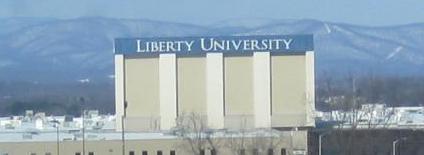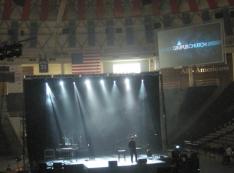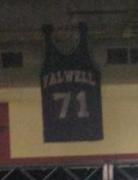If you noticed that Daylight Atheism was quieter than usual this past weekend, you were right – I was out of town and had limited internet access. But there was a good reason for my absence: I was on a secret mission to penetrate into the very heart of the Bible Belt. Namely, I was storming the gates of Liberty University, the evangelical Christian college founded by Jerry Falwell, infamous for banning the College Democrats from campus and for instantly expelling any student found to be gay. Would they recognize me on sight? Would some supernatural sense of discernment tell them that an atheist was among them? And what would they do if they did find out?
The idea for this trip developed several weeks ago, when one of my friends, a frequent traveler, mentioned having read The Unlikely Disciple, a book by a liberal Brown student who transferred to Liberty for a semester and wrote about his experiences there. I had likewise just finished The Preacher’s Son, a similar memoir about a survivor of an extreme fundamentalist family who accepted that he was gay while attending Liberty. A third friend of ours mentioned that she knew someone who attended the school and would be willing to show us around, and over a conversation, a plan was hatched. We set off on a road trip to Lynchburg, Virginia, with a few other stops along the way – one of which was Monticello, Thomas Jefferson’s home, which I may write about later – and at the end of our journey, we saw the sign that let us know we had arrived:
Lynchburg is a semi-suburban town in rural Virginia, sprawled around a tangle of highways and strip malls. Like many communities, I guessed, it owes most of its growth to the university, which was founded in 1971 by Falwell as Liberty Baptist College. The campus certainly dominates the town: it’s by far the largest institution there, its buildings and their prominently placed logos visible from far off. And just in case you missed the point, a giant “LU” is landscaped onto the side of a nearby mountain.
For all of that, getting onto campus was easier than I had hoped. There was no Soviet-style security, no checkpoints or guards at the gates controlling who entered or left campus, as I had been more than half-expecting. (I later learned that this is enforced in a different way: resident assistants perform nightly checks to ensure that every student is in their room by curfew, and undergrads must get written permission to stay off-campus overnight.) It would have looked just like any other college campus if not for the first building we passed, the first one that gave me a strange, world-turned-upside-down feeling of disorientation I’d experience many more times on this trip: an arena that was boldly lettered “LaHaye Ice Center”.
Our first priority on the trip was to attend a Sunday-morning church service, so we headed for the Vines Center, a domed structure that doubles as the stadium for sporting events and assemblies. When we walked in and found seats, I was taken aback: what stood at the center of the arena was not so much an altar as a stage, complete with swirling spotlights and a fog machine. It could have been the setting for any concert or rock show, if not for the signs scattered about (and for the sharp-eyed, notice the “Falwell” jersey hanging above the stage on the left):
We were early, and I was expecting a flood of people to arrive before services started, but the flood never materialized. I estimated that the stadium could hold around ten thousand people, but throughout the service, most of the seats were empty; I doubt the number in attendance ever got much above a thousand. Attendance at these services isn’t mandatory, although I’m told it used to be, and we later found out that many Liberty students attend Thomas Road, the nearby Baptist megachurch also founded by Falwell, or one of the other local churches in the area. (Liberty students are still required to attend convocation, a three-times-weekly mini-church service that includes prayer, announcements and worship songs.)
The stage setup was there for a reason, as we soon found out. The band arrived and took their places on stage, and the service began with a half hour of Christian rock music, during most of which the crowd was asked to stand. I had read in The Preacher’s Son that Liberty banned all rock music, even Christian rock, at the time the author attended, so it seems they’ve relaxed their rules somewhat since then. In any case, I doubt they ever had reason to worry: most Christian music is carefully devised to contain nothing that could possibly offend even the most uptight evangelical, and this was no exception. The music was technically accomplished, insofar as I’m any judge – it was a seven-piece band, with four different vocalists – but the lyrics were insipid and repetitive, each song consisting of the same chorus sung over and over again. It was easy to endure, although after a half hour, I thought I could feel my brain beginning to turn to mush.
But for all its calculated blandness, there were some disturbing undercurrents in the music’s message. One song praised Jesus as follows: “I know you’re my healer; you cure all my disease”. Needless to say, any Liberty student with diabetes or appendicitis would soon find out just how lethally untrue that claim is, if they took it literally and tried putting it to the test. Another one referred to Jesus as “the Lord of this city”, which was the kind of unsubtle theocratic message I had been expecting from the beginning.
The music was probably intended to work the crowd into a heighted emotional state, the standard tactic of mass manipulation, but if that was the effect they were seeking, they didn’t get it. There was no speaking in tongues, no students collapsing in their seats or hollering amens and hallelujahs. The most visible effect I noticed was a scattering of people raising their arms and swaying sedately in time to the music. That said, the whole spectacle was very well-produced and well-televised. Four enormous screens hanging around the interior of the stadium showed a close-up view of what was happening on stage, and there were cameras recording the action from every angle.
I was unmoved by the music, but there was just one part of the performance that I found genuinely affecting. In between two songs, one of the vocalists read a section from the Bible, from Hosea chapter 6. It was a good choice: there’s still some wonderful poetry in that old book, and this is one of the better examples:
Come, let us return to the Lord.
He has torn us to pieces
but he will heal us;
he has injured us
but he will bind up our wounds.After two days he will revive us;
on the third day he will restore us,
that we may live in his presence.Let us acknowledge the Lord;
let us press on to acknowledge him.
As surely as the sun rises,
he will appear;
he will come to us like the winter rains,
like the spring rains that water the earth.
That said, the band obviously skipped over some of the darker and bloodier parts of that very same book, like this one:
The people of Samaria must bear their guilt,
because they have rebelled against their God.
They will fall by the sword;
their little ones will be dashed to the ground,
their pregnant women ripped open.
The schizophrenic contrast between these passages just goes to show what a deeply conflicting book the Bible is: it blends beautiful, pastoral imagery with savage threats of hate and bloodshed, all supposedly sanctioned by God. Evangelicals arrive at the belief that the Bible is divinely inspired only by ignoring or downplaying the nastier parts, whereas atheists see this book for what it is: a mirror of the humans who wrote it, magnifying both their best and their worst traits and attributing both to a vindictive and omnipotent god.
Coming up: Part II of our heroes’ adventures at Liberty University, as the campus pastor takes the stage. Will he deliver a sermon to stir even the hardened heart of an atheist?


